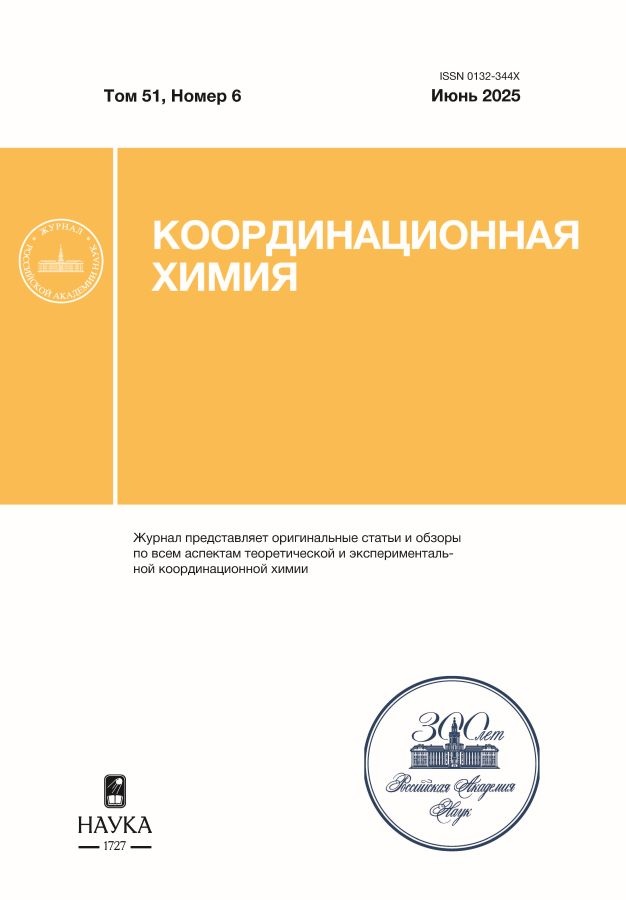Binuclear Diphenyltin(IV) Complexes with Salicylaldimine Ligands. Synthesis, Structure, Electrochemical Properties
- Авторлар: Klok V.A.1, Shangin P.G.1, Krylova I.V.1, Minyaev M.E.1, Syroeshkin M.A.1, Pechennikov V.M.2, Egorov M.P.1, Nikolaevskaya E.N.1
-
Мекемелер:
- Zelinsky Institute of Organic Chemistry Russian Academy of Sciences Moscow
- First Moscow State Medical University
- Шығарылым: Том 51, № 6 (2025)
- Беттер: 355-365
- Бөлім: Articles
- URL: https://rjonco.com/0132-344X/article/view/687245
- DOI: https://doi.org/10.31857/S0132344X25060011
- EDN: https://elibrary.ru/KIDIZC
- ID: 687245
Дәйексөз келтіру
Аннотация
New binuclear tin(IV) complexes based on salicylic Schiff bases and diphenyltin oxide Ph2SnO were obtained. The structures of the complexes were confirmed by 1H, 13C and 119Sn NMR spectroscopy and X-ray diffraction analysis (CCDC 2433411). UV-Vis spectroscopy of complexes 1–4 showed that a bathochromic shift of all ligand absorption bands was observed upon complexation with the metal fragment. The ability of complexes 1–4 to undergo electrochemical transformations was investigated by cyclic voltammetry. In all cases, the oxidation and reduction of the complexes are irreversible. In the cases of complexes 2–4 with a conjugated bridge, the oxidation of two metal fragments occurs at one potential, whereas complex 1 with an unconjugated adipic bridge has two peaks on the oxidation curve at different potentials, which is probably since the oxidation of two different ‘ends’ of the molecule occurs at different potentials.
Негізгі сөздер
Толық мәтін
Авторлар туралы
V. Klok
Zelinsky Institute of Organic Chemistry Russian Academy of Sciences Moscow
Email: en@ioc.ac.ru
Ресей, Moscow, 119991
P. Shangin
Zelinsky Institute of Organic Chemistry Russian Academy of Sciences Moscow
Email: en@ioc.ac.ru
Ресей, Moscow, 119991
I. Krylova
Zelinsky Institute of Organic Chemistry Russian Academy of Sciences Moscow
Email: en@ioc.ac.ru
Ресей, Moscow, 119991
M. Minyaev
Zelinsky Institute of Organic Chemistry Russian Academy of Sciences Moscow
Email: en@ioc.ac.ru
Ресей, Moscow, 119991
M. Syroeshkin
Zelinsky Institute of Organic Chemistry Russian Academy of Sciences Moscow
Email: en@ioc.ac.ru
Ресей, Moscow, 119991
V. Pechennikov
First Moscow State Medical University
Email: en@ioc.ac.ru
Ресей, Moscow, 119048
M. Egorov
Zelinsky Institute of Organic Chemistry Russian Academy of Sciences Moscow
Email: en@ioc.ac.ru
Ресей, Moscow, 119991
E. Nikolaevskaya
Zelinsky Institute of Organic Chemistry Russian Academy of Sciences Moscow
Хат алмасуға жауапты Автор.
Email: en@ioc.ac.ru
Ресей, Moscow, 119991
Әдебиет тізімі
- Nikolaevskaya E.N., Syroeshkin M.A., Egorov M.P. // Mend. Commun. 2023. V. 33, P. 733. https://doi.org/10.1016/j.mencom.2023.10.001
- Cozzi P.G. // Chem. Soc. Rev. 2004. V. 33. P. 410. https://doi.org/10.1039/b307853c
- Fallah-Mehrjardi M., Kargar H., Munawar K.S. // Inorg. Chim. Acta. 2024. V. 560. P. 121835. https://doi.org/10.1016/j.ica.2023.121835
- Juyal V.K., A. Pathak M., Panwar S.C. et al. // J. Organomet. Chem. 2023. V. 999. P. 122825. https://doi.org/10.1016/j.jorganchem.2023.122825
- Iacopetta D., Catalano A., Ceramella J. et al. // Molecules. 2025. V. 30. P. 207. https://doi.org/10.3390/molecules30020207
- Lindoy L.F., Park K.-M., Lee S.S. // Chem. Soc. Rev. 2013. V. 42. P. 1713. https://doi.org/10.1039/C2CS35218D
- Middya P., Roy D., Chattopadhyay S. // Inorg. Chim. Acta. 2023. V. 548. P. 121377. https://doi.org/10.1016/j.ica.2023.121377
- Zhang J., Xu L., Wong W.-Y. // Coord. Chem. Rev. 2018. V. 355. P. 180. https://doi.org/10.1016/j.ccr.2017.08.007
- Akbulatov A.F., Akyeva A.Y., Shangin P.G. et al. // Membranes. 2023. V. 13. P. 439. https://doi.org/10.3390/membranes13040439
- Singh H.L., Khaturia S., Solanki V.S. et al. // J. Indian Chem. Soc. 2023. V. 100. P. 100945. https://doi.org/10.1016/j.jics.2023.100945
- Dieng M., Gningue-Sall D., Jouikov V. // Main Group Met. Chem. 2012. V. 35. P. 141. https://doi.org/10.1515/mgmc-2012-0059
- Nikolaevskaya E.N., Saverina E.A., Starikova A.A. et al. // Dalton Trans. 2018. V. 47. P. 17127. https://doi.org/10.1039/C8DT03397H
- Nikolaevskaya E.N., Shangin P.G., Starikova et al. // Inorg. Chim. Acta. 2019. V. 495. P. 119007. https://doi.org/10.1016/j.ica.2019.119007
- Shangin P.G., Krylova I.V., Lalov A.V. et al. // RSC Adv. 2021. V. 11. P. 21527. https://doi.org/10.1039/D1RA02691G
- Shangin P.G., Akyeva A.Y., Vakhrusheva D.M. et al. // Organometallics. 2023. V. 42. P. 2541. https://doi.org/10.1021/acs.organomet.2c00607
- Kozmenkova A.Y., Timofeeva V.A., Mankaev B.N. et al. // Eur. J. Inorg. Chem. 2021. P. 2755. https://doi.org/10.1002/ejic.202100369
- Baryshnikova S.V., Bellan E.V., Poddel’sky A.I. et al. // Eur. J. Inorg. Chem. 2016. V. 2016. P. 5230. https://doi.org/10.1002/ejic.201600885
- Baryshnikova S.V., Poddel’sky A.I., Bellan E.V. et al. // Inorg. Chem. 2020. V. 59. P. 6774. https://doi.org/10.1021/acs.inorgchem.9b03757
- Baryshnikova S.V., Bellan E.V., Poddel’sky A.I. et al // Inorg. Chem. Comm. 2016. V. 69. P. 94. https://doi.org/10.1016/j.inoche.2016.05.003
- Smolyaninov I.V., Burmistrova D.A., Pomortseva N.P. et al. // Russ. J. Coord. Chem. 2023. V. 49. P. 124. https://doi.org/10.1134/S1070328423700446
- Protasenko N.A., Baryshnikova S.V., Cherkasov A.V. et al. // Russ. J. Coord. Chem. 2022. V. 48. P. 478. https://doi.org/10.1134/S1070328422070077
- Piskunov A.V., Trofimova O.Yu., Fukin G.K. et al. // Dalton Trans. 2012. V. 41. P. 10970. https://doi.org/10.1039/C2DT30656E
- Krylova I.V., Proshutinskaya V.Yu., Labutskaya L.D. et al. // J. Organomet. Chem. 2025. V. 1028. P. 123527. https://doi.org/10.1016/j.jorganchem.2025.123527
- Krylova I.V., Labutskaya L.D., Markova M.O. et al. // New J. Chem. 2023. V. 47. P. 11890. https://doi.org/10.1039/D3NJ01993D
- Krylova I.V., Saverina E.A., Rynin S.S. et al. // Mend. Commun. 2020. V. 30. P. 563. https://doi.org/10.1016/j.mencom.2020.09.003
- Pandey V.K., Singh V.K., Chandra S. et al. // J. Coord. Chem. 2019. V. 72. P. 1537. https://doi.org/10.1080/00958972.2019.1606908
- Dubey M., Kumar A., Gupta R.K. et al. // Chem. Commun. 2014. V. 50. P. 8144. https://doi.org/10.1039/C4CC02591A
- Ali M.S., Kuraijam D., Karnik S. et al. // Kuwait J. Sci. 2023. V. 50. P. 1. https://doi.org/10.48129/kjs.21599
- Wilson B.H., Scott H.S., Qazvini O.T. et al. // Chem. Commun. 2018. V. 54. P. 13391. https://doi.org/10.1039/C8CC07227B
- Rakesh K.P., Vivek H.K., Manukumar H.M. et al. // RSC. Adv. 2018. V. 8. P. 5473. https://doi.org/10.1039/C7RA13661G
- Li Z., Wang Q., Wang J. et al. // Inorg. Chim. Acta. 2020. V. 500. P. 119231. https://doi.org/10.1016/j.ica.2019.119231
- Perrin D.D., Armarego W.Li.F., Perrin D.R. Purification of Laboratory Chemicals. Oxford: Pergamon Press, 1988.
- CrysAlisPro. Version 1.171.41. Rigaku Oxford Diffraction, 2021.
- Sheldrick G.M. // Acta Crystallogr. A. 2015. V. 71. № 1. P. 3. http://doi.org/10.1107/S2053273314026370
- Sheldrick G.M. // Acta Crystallogr. C. 2015. V. 71. № 1. P. 3. http://doi.org/10.1107/S2053229614024218
- Dolomanov O.V., Bourhis L.J., Gildea R.J. et al. // J. Appl. Cryst. 2009. V. 42. P. 229. http://doi.org/10.1107/S0021889808042726
Қосымша файлдар



















